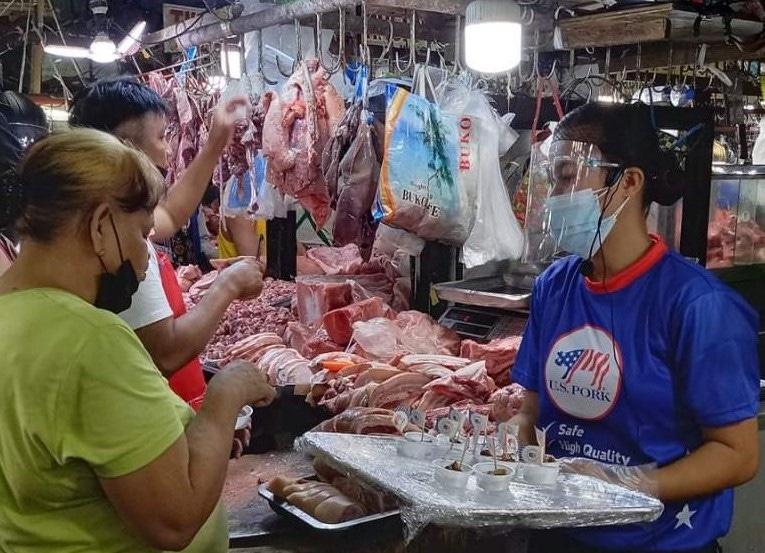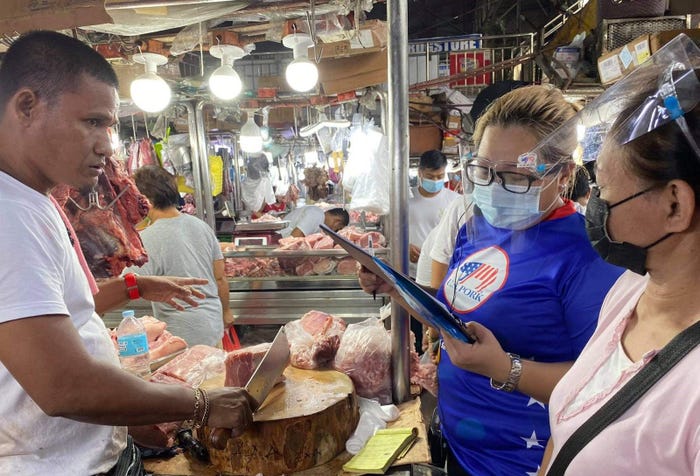Philippines has been a well-established destination for U.S. pork for many years, but exports have been largely limited to raw material for further processing.
March 9, 2022

To capitalize on growing demand for imported pork in the Philippines, the U.S. Meat Export Federation promoted U.S. pork for the first time in Philippine wet markets in 2021. The promotions, made possible through support from the National Pork Board, are set for further expansion this year as the Philippines continues the process of rebuilding its domestic pork production, which has been heavily impacted by African swine fever, transportation challenges and rising input costs.
Although the Philippines has a growing modern retail sector, much of the fresh pork consumed in the country is purchased in traditional wet markets, which serve both end consumers and restaurant operators.
"Wet markets have been even more popular during the COVID-19 pandemic because many consumers have suffered job or income losses and have less disposable income," says Dave Rentoria, USMEF representative in the Philippines. "Meat prices offered in wet markets are often lower than in supermarkets, sometimes 20 to 30% lower. And there is a love for bargaining in the Philippine culture, so many wet market shoppers are looking to negotiate a lower price."
The first phase of the U.S. pork promotions began in the summer of 2021, focusing on increasing vendor and consumer awareness of U.S. pork and its quality and versatility. Surveys were used to document information on pricing and the availability of U.S. pork at various locations. USMEF also provided educational information to vendors about the attributes and advantages of U.S. pork.
The second phase, which began last fall, involved education and training in merchandising, product identification and the value of sharing information and recipe ideas. Phase three will demonstrate to vendors how expanding their offerings and merchandising of U.S. pork can bolster their profitability.

Given the positive response from vendors and consumers, the U.S. pork promotions are expanding to additional regions this year, extending beyond the Manila metropolitan area.
"Beginning in March, the campaign will expand to wet markets in the central Luzon region, specifically in the provinces of Bulacan and Pampanga," said Rentoria. "This is very much a pork-eating region and one of the areas hit hardest by ASF. We will also be launching promotions in the provinces of Laguna and Cavite, located in the Calabarzon region south of Manila."
The Philippines has been a well-established destination for U.S. pork for many years, but exports have been largely limited to raw material for further processing. This was due in part to high tariff rates on imported pork muscle cuts – 30% within a minimum access volume quota and 40% outside the quota – which are the highest tariff rates imposed by any major pork importer. These high tariffs made it difficult for the Philippines to attract imported product, especially in times of tight global supplies when China and other ASF-affected countries were importing more pork.
Last year the Philippine government took steps to address this issue, increasing the MAV quota from 54,210 metric tons to 254,210 mt. The normal in-quota tariff rate of 30% was reduced in April 2021 and, following adjustments, is currently set at 15% through an order issued in May 2021. The 40% out-of-quota rate was cut to 25% under the same order. Although the expanded MAV quota expired on Jan. 31, the reduced in-quota and out-of-quota tariff rates are in place through May 17, 2022.
Philippine importers are calling for renewal of the expanded MAV quota, but domestic pork producer organizations argue that it was not effective in lowering retail pork prices. The Philippines imported much larger volumes from its major pork suppliers in 2021, as imports from the United States more than doubled and shipments of European and Canadian pork increased at even higher rates. Imports from Brazil also rose dramatically.* Much of the volume was imported outside the MAV quota, but still benefited from lower tariff rates.
"The U.S. industry would welcome an extension of the larger quota," says USMEF Economist Erin Borror. "But because a high percentage of imports don't qualify for in-quota tariff treatment, the size of the quota has become less relevant than the lower tariff rates. Extending those rate reductions beyond mid-May is a major policy decision, because attracting imported pork will be much more difficult if the world's highest tariff rates return to the Philippines."
*In 2021 (through November), imported pork cuts entering the Philippines totaled 244,208 mt, up 305% from the same period in 2020, including larger volumes from:
European Union and United Kingdom – 111,080 mt, up 405% year-over-year
Canada – 66,462 mt, up 264%
United States – 46,733 mt, up 170%
Brazil – 18,692 mt, up 636%
Source: Trade Data Monitor
Source: U.S. Meat Export Federation, which is solely responsible for the information provided, and wholly owns the information. Informa Business Media and all its subsidiaries are not responsible for any of the content contained in this information asset.
About the Author(s)
You May Also Like



